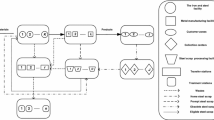Abstract
In logistics system, facility location–allocation problem, which can be used to determine the mode, the structure and the form of the whole logistics system, is a very important decision problem in the logistics network. It involves locating plants and distribution centers, and determining the best strategy for allocation the product from the plants to the distribution centers and from the distribution centers to the customers. Often uncertainty may be associated with demand, supply or various relevant costs. In many cases, randomness and fuzziness simultaneously appear in a system, in order to describe this phenomenon; we introduce the concept of hybrid variable and propose a mixed-integer programming model for random fuzzy facility location–allocation problem. By expected value and chance constraint programming technique, this model is reduced to a deterministic model. Furthermore, a priority-based genetic algorithm is designed for solving the proposed programming model and the efficacy and the efficiency of this method and algorithm are demonstrated by a numerical example. Till now, few has formulated or attacked the FLA problems in the above manner. Furthermore, the techniques illustrated in this paper can easily be applied to other SCN problems. Therefore, these techniques are the appropriate tools to tackle other supply chain network problems in realistic environments.
Similar content being viewed by others
References
Amid A., Ghodsypour S. H., Brien C. O’. (2006) Fuzzy multiobjective linear model for supplier selection in a supply chain. International Journal of Production Economics 104: 394–407
Badri M. A. (1999) Combining the analytic hierarchy process and goal programming for global facility location–allocation problem. International Journal of Production Economic 62: 237–248
Chen C.-L., Lee W.-C. (2004) Multi-objective optimization of multi-echelon supply chain networks with uncertain product demands and prices. Computers and Chemical Engineering 28: 1131–1144
Choudhary A. K., Singh K. A., Tiwari M. K. (2006) A statistical tolerancing approach for design of synchronized supply chains. Robotics and Computer-Integrated Manufacturing 22: 315–321
Cooper L. (1963) Location–allocation problems. Operational Research 11: 331–344
Dubois D., Prade H. (1988) Possibility theory: An approach to computerized processing of uncertainty. Plenum Press, New York
Ernst A. T., Krichnamoorthy M. (1999) Solution algorithms for the capacitated single allocation hub location problem. Annals of Operations Research 86: 141–159
Gen M., Cheng R. (2000) Genetic algorithms and engineering optimization. Wiley, New York
Gen M., Cheng R., Lin L. (2008) Network models and optimization: Multiobjective genetic algorithm approach. Springer, London
Gong D., Gen M., Xu W., Yamazaku G. (1995) Hybrid evolutionary method for obstacle location–allocation problem. International Journal of Computers and Industrial Engineering 29: 525–530
Hakimi S. L. (1964) Optimum locations of switching centers and absolute centers and medians of a graph. Operations Research 12: 450–459
Hakimi S. L. (1965) Optimum distribution of switching centers in a communication network and some related graph theoretic problems. Operations Research 13: 462–475
Hodey M., Melachrinoudis E., Wu X. (1997) Dynamic expansion and location of an airport: A multiple objective approach. Transportation Research Part A—Policy and Practice 31: 403–417
Kaufmann A. (1975) Introduction to the theory of fuzzy subsets, Vol. 1. Academic Press, New York
Kuenne R. E., Soland R. M. (1972) Exact and approximate solutions to the multisource Weber problem. Mathematical Programming 3: 193–209
Kulak O., Kahraman C. (2005) Fuzzy multi-attribute selection among transportation companies using axiomatic design and analytic hierarchy process. Information Sciences 170: 191–210
Kwakernaak H. (1978) Fuzzy random variables–I. Information Sciences 15: 1–29
Lin, L., & Gen, M., (2007). Bicriteria network design problem using interactive adaptive weight GA and Priority-based encoding method”. IEEE Transactions on Evolutionary Computation (in Reviewing).
Liu B. (2002) Theory and practice of uncertain programming. Physica-Verlag, Heidelberg
Liu B. (2006) A survey of credibility theory. Fuzzy Optimization and Decision Making 5(4): 387–408
Logendran R., Terrell M. P. (1998) Uncapacitated plant location–allocation problems with price sensitive stochastic demands. Computers and Operations Research 15: 189–198
MirHassani A. S., Lucas C., Mitra G. (2000) Computational solution of capacity planning models under uncertainty. Parallel Computing 26: 511–538
Murray A. T., Church R. L. (1996) Applying simulated annealing to location-planning models. Journal of Heuristics 2: 31–53
Murtagh B. A., Niwattisyawong S. R. (1982) Efficient method for the muti-depot location em dash allocation problem. Journal of the Operational Research Society 33: 629–634
Nahmias S. (1978) Fuzzy variables. Fuzzy Sets and Systems 1: 97–110
Santoso T., Ahmed S., Goetschalckx M. (2005) A stochastic programming approach for supply chain network design under uncertainty. European Journal of Operations Research 167: 96–115
Tsiakis P., Shah N., Pantelides C. C. (2001) Design of multiechelon supply chain networks under demand uncertainty. Industrial and Engineering Chemistry Research 40: 3585–3604
Wang J., Shu Y.-F. (2007) A possibilistic decision model for new product supply chain design. European Journal of Operational Research 177: 1044–1061
Wen M., Iwamura K. (2008) Fuzzy facility location–allocation problem under the Hurwicz criterion. European Journal of Operational Research 184: 627–635
Zadeh L. A. (1978) Fuzzy sets as a basis for a theory of possibility. Fuzzy Sets and Systems 1: 3–28
Zhou J. (2000) Uncapacitated facility layout problem with stochastic demands. Proceedings of the Sixth National Conference of Operations Research Society of China, China (pp. 904–911).
Zimmermann H. J. (1978) Fuzzy programming and linear programming with several objective functions. Fuzzy Sets and Systems 1: 45–55
Author information
Authors and Affiliations
Corresponding author
Rights and permissions
About this article
Cite this article
Liu, Q., Xu, J. A study on facility location–allocation problem in mixed environment of randomness and fuzziness. J Intell Manuf 22, 389–398 (2011). https://doi.org/10.1007/s10845-009-0297-3
Received:
Accepted:
Published:
Issue Date:
DOI: https://doi.org/10.1007/s10845-009-0297-3




